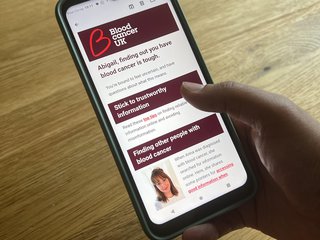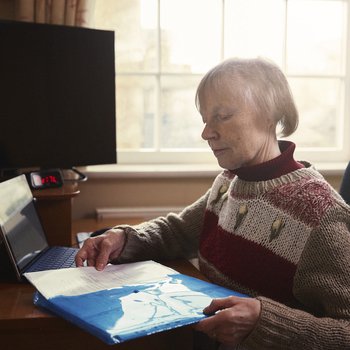Diffuse large B-cell lymphoma (DLBCL)
Diffuse large B-cell lymphoma (DLBCL) is a type of non-Hodgkin lymphoma. It affects white blood cells called lymphocytes.

Diffuse large B-cell lymphoma (DLBCL) at a glance
There are two main types of lymphoma: Hodgkin lymphoma and non-Hodgkin lymphoma. Non-Hodgkin lymphoma can be high-grade (fast-growing) or low-grade (slow-growing).
Diffuse large B-cell lymphoma (DLBCL) is the most common type of high-grade non-Hodgkin lymphoma (NHL).
Over 10,000 people are diagnosed with a type of NHL every year in the UK. Around one in three have diffuse large B-cell lymphoma (DLBCL).
Diffuse large B-cell lymphoma (DLBCL) is more common in older people and rarely seen in children.
Learn more about diffuse large B-cell lymphoma (DLBCL)
Sign up to our weekly support email for people recently diagnosed.
It gives you clear and simple information, practical tips and advice from others with blood cancer, to help during the first few weeks and months after diagnosis.
If someone you love has been diagnosed with DLBCL, you might find our information for family and friends helpful. It covers how to support someone with blood cancer, practical tips, coping with your own emotions, and real stories from other friends and family members.
You may also want to try our podcast for family and friends, Blood Cancer Heart to Heart, featuring honest conversations between people who know what it's like to have a loved one diagnosed with blood cancer.
We don’t know exactly what causes DLBCL, but some factors make it more likely, including:
- age
- sex
- family history
- Infections
Read more about causes of DLBCL
The main symptom of DLBCL is swollen lymph glands in your neck, armpit or groin. A range of tests will be used to confirm whether you have DLBCL, and help doctors decide how to treat it.
More about DLBCL symptoms and diagnosis
The main treatment for DLBCL is chemotherapy. Sometimes treatment involves radiotherapy too.
Read more about DLBCL treatment and side effects
Most people with DLBCL go into remission after standard treatment with chemotherapy, meaning there's no sign of lymphoma left in their body. Some people will need further treatment.
Find more on the prognosis for DLBCL
Clinical trials are how we find new treatments and improve current ones. We can help you find out about clinical trials for DLBCL. Even if you just want to know a bit more about DLBCL research, try our Clinical Trials Support Service.
Our research in lymphoma has focused on improving treatments. Read about our scientific impact on lymphoma.

Get a weekly support email from us
We'll send you clear and simple information, practical tips, and advice from other people with blood cancer, to help during the first few weeks and months after diagnosis.



